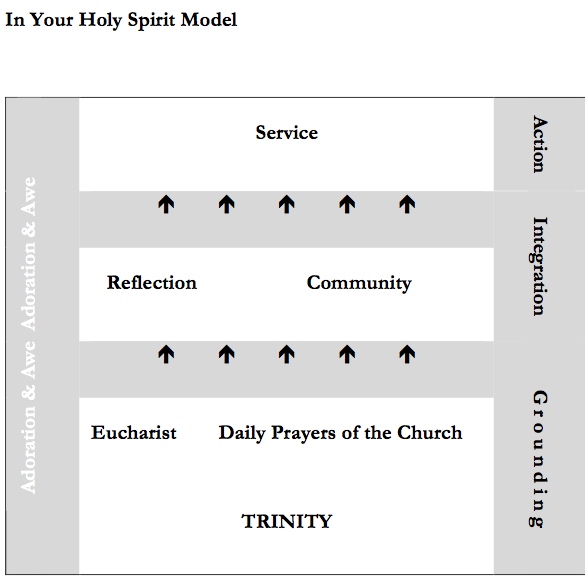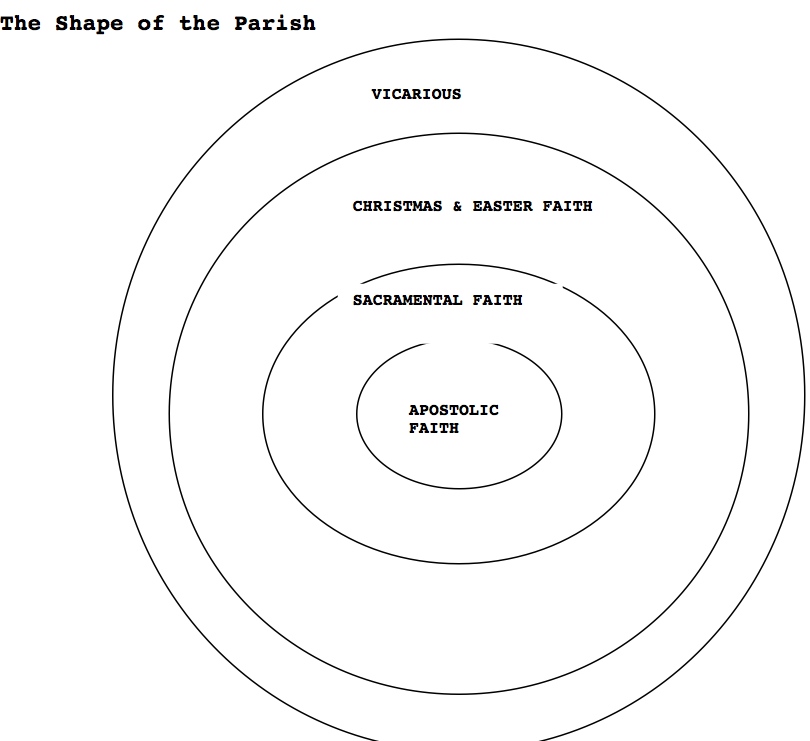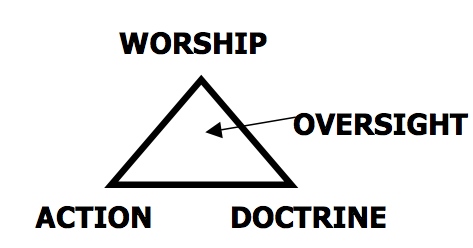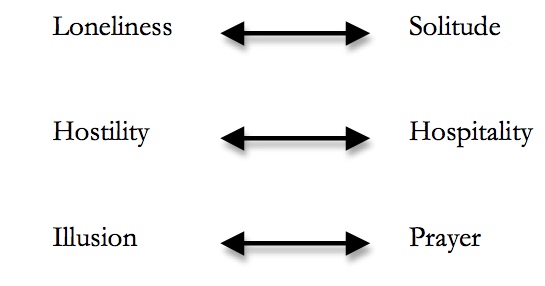Understanding from Within
PDF of the article - "Understanding from Within: Working with Religious Systems"
The article was written for members of the OD Network, the largest professional association of organization development practitioners. That's a largely secular audience and the piece is written in a manner that reflects that. The material on this page is provided for those OD Practitioners who want more information on the models mentioned in the article. It's also a resource for parish development practitioners in the church seeking resources.
 Renewal-Apostolate Cycle
Renewal-Apostolate Cycle
The Renewal ‐ Apostolate Cycle is a way of describing a central dynamic of Christian life. The Cycle focuses our attention on the Christian’s movement between being renewed in baptismal identity and purpose and living as instruments of God’s love and grace in daily life--in our families, with friends, in the workplace, and in our civic life. The cycle is between a conscious and intentional attention to God, prayer life, our relationships, Christian formation and a subconscious reliance upon God as members of the Body of Christ, in the workplace, family, friendship, civic life and congregational life. The primary task of the parish church is the glorification of God and the sanctification of the people. It is to provide the climate, prayer life and other resources that renew baptized members in their faith and practice so they may be instruments of the Divine Compassion in daily life.
Book: Fill All Things: The Dynamics of Spirituality in the Parish Church Chapter 1.
Questions for parish leaders -
 In Your Holy Spirit Model
In Your Holy Spirit Model
This model has five elements; five spiritual practices. At the base there are two practices—one weekly, one daily. That rhythm is common to many religious and spiritual traditions. These elements have to do with living in the habits and ways that keep us grounded in that tradition. In Anglicanism they take form as the Holy Eucharist (Mass) and the Daily Office (Daily Prayer of the Church).
Above them are two more spiritual practices standing side-by-side—Community and Reflection. We participate in imperfect communities that we allow to nurture and influence us, including a parish church. Reflection includes developing our capacity to be silent and still; to listen to God, one another, the Scriptures and the Tradition; and to learn from our experience.
The final element is Service. Individuals serve in ways that fit their gifts and temperament. The parish develops an expression of common and shared service. The assumption is that such service will be more fruitful and authentic, and less self serving, when it sits upon the base of the other four spiritual practices.
PDF - In Your Holy Spirit model
Books:
Anglican Spiritual Practices Course
This course is best offered on a schedule that picks up people within 4 months of becoming somewhat regular in attendance. Here is Michelle Heyne's education design - "Teaching Spiritual Practice: Experiential Approach to Christian Formation and Parish Development." For use with In Your Holy Spirit: Traditional Spiritual Practices in Today's Christian Life This has been used in many parishes during the pre-Advent/Advent period and/or during Lent. It's most effective when offered each year as a way of assisting in the incorporation of newer members.
Assessments
Assessing your Spiritual Practices - An assessment form for individuals
Parish Assessment of Spiritual Practices - An assessment of the parish
 Shape of the Parish
Shape of the Parish
This model assumes that people are in many different places in regard to spiritual life--some more disciplined, others more lax; some with an "owned" faith, others more tentative and possibly immature. All are loved by God, all are part of the Body of Christ. People need to be accepted where they are in the spiritual journey. We also assume that a parish is healthier when there is a critical mass of people who are more proficient in the practices of faith.That group grounds the parish in a more mature faith and creates a climate conducive to growth in faith. People need to be invited to grow and move forward in the spiritual life. A related organizational model is the Critical Mass Model
Book: Fill All Things: The Dynamics of Spirituality in the Parish Church Chapter 4.
Question for parish leaders - Do we have an effective strategy that deepens the parish's spiritual life, while staying open to the various places people are in their faith journey? [Note: The rector has primary responsibility for this. The vestry's role is largely one of expecting the rector to address it.]
 The Christian Life Model
The Christian Life Model
This model has at its center three interdependent threads -- Worship, Doctrine, and Action. Each is, for the parish and the individual, a pathway into deeper life in Christ.
Books
Fill All Things: The Dynamics of Spirituality in the Parish Church Chapter 2.
Power from on High: A Model for Parish Life and Development - earlier version from 1982
Blog posting - The Christian Life Model -The four most common mistakes
Assessments
Assessment of Parish Life and Ministry
 The Benedictine Promise
The Benedictine Promise
The Benedictine tradition includes a promise of stability, obedience, and conversion of life. The Promise establishes an orientation toward healthy parish life and development in the Anglican tradition. These three aspects of spirituality are brought together into one promise and a paradox. The promise is a way to assess the congregation’s dynamics and structures and for shaping the culture of the congregation.
Seeking God: The Way of St. Benedict, Esther de Wall
 Three Movements of the Spiritual Life
Three Movements of the Spiritual Life
Henri Nouwen's offers one of the most useful resources for understanding and assessing the spiritual dynamics of a parish church as well as in the life of individual baptized person. Nouwen sees our spiritual life as involving three movements of constant movement between the poles of loneliness and solitude, hostility and hospitality, illusion and prayer. The more we come to the painful confession of our loneliness, hostility and illusions, the more we are able to see solitude, hospitality and prayer as part of the vision of our life.
From loneliness to solitude
To live a spiritual life we must first find the courage to enter into the desert of our loneliness and to change it by gentle and persistent efforts into a garden of solitude.
From hostility to hospitality
Hospitality means primarily the creation of free space where the stranger can enter and become a friend instead of an enemy. Hospitality is not to change people, but to offer them space where change can take place. It is not to bring men and women over to our side, but to offer freedom not disturbed by dividing lines.
Receptivity without confrontation leads to a bland neutrality that serves nobody. Confrontation without receptivity leads to an oppressive aggression which hurts everybody.
From illusion to prayer
Solitude and hospitality can only bear lasting fruits when they are embedded in a broader, deeper and higher reality from which they receive their vitality. …The movement from illusion to prayer undergirds and makes possible the movements from loneliness to solitude and from hostility to hospitality and leads us to the core of the spiritual life.
Confession and seeing
The spiritual life is that constant movement between the poles of loneliness and solitude, hostility and hospitality, illusion and prayer. The more we come to the painful confession of our loneliness, hostility and illusions, the more we are able to see solitude, hospitality and prayer as part of the vision of our life.
Book
Reaching Out: The Three Movements of the Spiritual Life